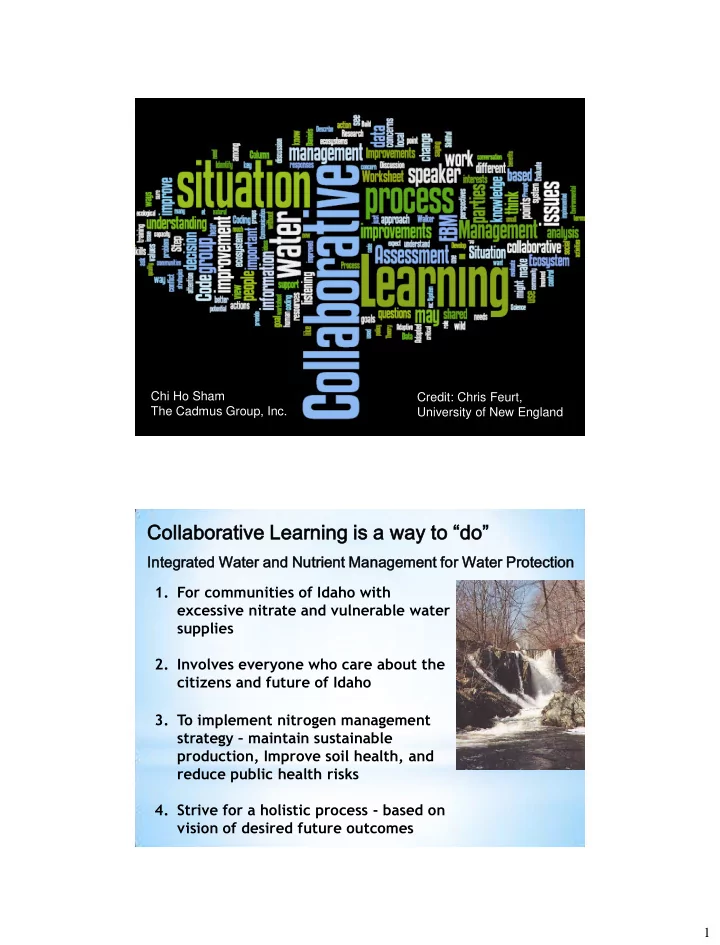

Chi Ho Sham Credit: Chris Feurt, The Cadmus Group, Inc. University of New England Collaborative Learning is a way to “do” Inte tegrat ated ed Wate ter and Nutrien ient t Manag agemen ent t for Wate ter Prot otect ection ion 1. For communities of Idaho with excessive nitrate and vulnerable water supplies 2. Involves everyone who care about the citizens and future of Idaho 3. To implement nitrogen management strategy – maintain sustainable production, Improve soil health, and reduce public health risks 4. Strive for a holistic process - based on vision of desired future outcomes 1
Collaborative Learning Engages The Kaleidoscope of Expertise – to improve water quality Regulations, Ordinances & Enforcement Land Conservation & Planning & Nutrient Land Use Management Management Engineering Drinking/Source Public Works Water Protection and Wastewater Science: Water Citizen & Research & Business Monitoring Watershed Stewardship Education & Community Outreach Collaborative Learning designs events to engage the Kaleidoscope of Expertise as a Resource not a Receptacle Adult Learning Theory Land Drinking Conservation H2O Planning Research & Land Use & Monitoring Water is Water is Water is Valued Threatened Protected Regs & Education & Enforcement Outreach Citizen Engineering & Public Safety Stewardship TEC 2
Implementing a Collaborative Learning Event 1. The “Way I See It…” 2. Listening for most promising ideas 3. Most promising ideas brainstorm 4. Ideas for Actions & Measures of Success * Partner -up and share your most promising idea uninterrupted for 5 minutes (each) * Listener keeps time * Total time for both to share 15 minutes * Primes the pump for brainstorming to follow * Make notes after returning from conversation Listening for “most promising idea” 3
Promising Ideas … Make the conservation work by producers easier Are achievable in a reasonable timeframe Are connected by a clear path to desired outcomes May be the first step of a long-term strategy Respect the realities of the culture within and constraints associated with stakeholders work Promising Ideas ... Provide missing information vital to the messages Identify key stakeholders not present in the room Connect to important policy initiatives to accomplish outcomes Identify concrete management practices that link to outcomes 4
Ideas for Action Most How will this What actions Who needs What do we promising idea idea improve would make to be need to be the situation? this idea a involved to aware of? reality? implement OUTCOME the idea? Identify areas Guidance and 1. Overlay maps of 1. Producers 1. Take action to that are both management nutrient reduction 2. Crop advisor find evidence for priority nutrient actions can be priority areas with 3. NRCS and quantify reduction areas targeted at time-of-travel 4. FSA effects of and susceptible priority areas/ areas of 5. IDEQ nutrient water supply vulnerable areas vulnerable water 6. USGS reduction on the areas for to reduce supplies lowering of * implementation nutrient inputs 2. Evaluate and nitrate of nutrient that can improve rank drinking concentration in reduction water quality water quality data groundwater. practices to to identify 2. Important to reduce nitrate hotspots examine our concentration 3. Communicate assumptions and with producers for identify the nutrient reduction source of inputs. implementation Measures of Success Action Items Measures of Accountability Comments Success 1. Examine water Water quality data Water system Identify gaps in quality data after are collected with operators and coverage of existing implementation of sufficient municipal staff sampling regime. nutrient reduction geographic coverage Share results within strategy and sampling the sampling timeframe network. 2. Obtain baseline Water quality Producers and ag. Change in water water quality data improvement agencies quality will take * for comparison observed after time. Would be purposes implementation of important to specify nutrient reduction timeline. practices 5
6
Recommend
More recommend